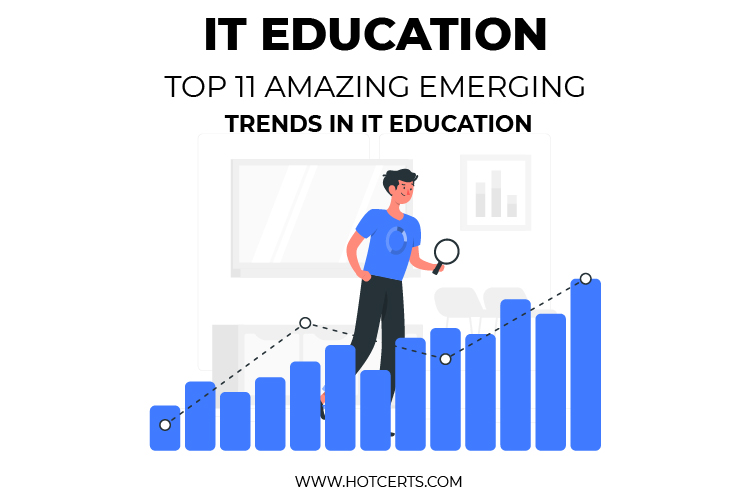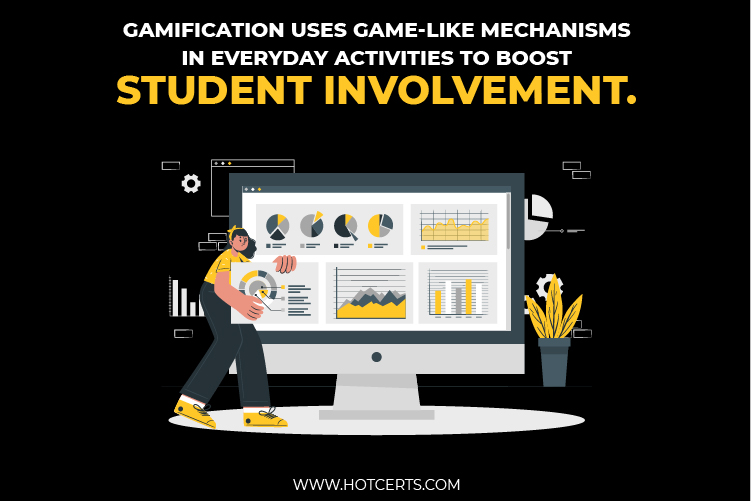What is Educational Technology or ED-Tech?
Educational technology concerns adopting new tools in the classroom to create a better learning experience. Ed-tech allows educators to provide information effectively and optimally to maintain learning. It has transformed traditional teaching methods into a more immersive experience. There are some new trends in educational technology, such as Internet of Things devices and artificial intelligence. This interactive technology has enabled students to take advantage of more attractive learning methods and helped teachers with grade evaluation tasks.
The functioning of society is very different from what it was before the digital revolution began. New tools, from social media to digital transaction management, have restructured the way people interact and do business. The digital age has a particular impact on our learning methods. Classrooms have become one of the fastest-growing markets for new technologies. Educational Technology (Ed Tech) includes many of the popular digital developments such as the Internet of Things (IoT) and Virtual Reality (VR). Still, it has its application dedicated to educational tasks. Therefore, the education sector offers an important opportunity for tech entrepreneurs looking for a promising market.
Why is Educational Technology so important?
The Internet and computers are as popular as textbooks and pencils in today’s schools. Combining these devices with educational technology can improve student performance. Technology helps educators determine the needs and requirements of all students and create personalized solutions. Technologies such as automatic scoring can reduce the burden on educators and provide a more engaging learning experience.
Technology is already a part of many students’ daily lives, so there is an opportunity to use it to promote education. Modern learners do not want to sit passively while the teacher gives a lecture. They want to experience. Ed-tech allows educators to connect with young minds and educate interactively. Overall, current trends in educational skills help teachers catch up with students’ interests.
Why is it important?
There are many reasons educators have replaced traditional paper and pen teaching methods with EdTech. In particular, here are some of the expected benefits of EdTech that you can easily see here.
Innovative teaching method
Technology is a human innovation, so if an educator can apply it to education, it is also innovative. With EdTech, teachers can provide multimedia to accommodate various learning styles, including animation and live video. Moreover, EdTech allows teachers to create online courses that will enable students to study at their own pace in their own space.
Improve joint education
Technology has made it viable for everyone to stay related and interconnected. Students and teachers connect, share ideas, discuss, and work together in context. For example, e-learning is an educational tool that features collaboration that allows students to share and discuss. Instead of being in the classroom and listening to the teacher for 30 minutes, e-learning students can join an online group/platform and interact with peers to learn together. In this case, the teacher is more accessible and acts as a mentor to help the student grow himself. This collaborative approach also bridges the gap between teachers and students and helps students strengthen their interpersonal skills.
Education and learning process
First, EdTech benefits the way teachers teach both online and offline. Students don’t always have to go to a particular class at a specific time; students can study anytime, anywhere. Second, EdTech will transform the way students approach learning. EdTech drives learning to be more fun and exciting for students. When we feel engaged in learning, we understand better, remember better, and apply our knowledge to real life. Finally, technology makes education more innovative and more effective, allowing it to meet the needs of learners better. True educators bring valuable knowledge to learners, both in theory and real life. But wise educators can create education from what the learner wants to learn.
Top 11 latest education trends for you to know in 2022
Keeping up with the trend of innovative educational technology is essential for modern educators. State-of-the-art technology allows educators to improve the student experience and reduce the burden of repetitive tasks.
So what are the latest trends in ED-Tech or educational technology that you can anticipate this year?
1. E-learning
Distance learning quickly became the norm when schools worldwide were closed to limit the spread of COVID-19. As a result, the demand for e-learning platforms has increased, and overnight, this technology has become one of the hottest educational technology trends. The e-learning platform allows you to deliver educational content over the phone, laptop, and computer.
E-learning has opened the door for educators to cross classroom boundaries and teach students. Many educators use animations, podcasts, and videos to make their e-learning experience more enjoyable and interactive. From customized learning environments to cost-effective ones, e-learning has many benefits. Therefore, this trend will grow in the future.
2. Video support learning
It stopped another beneficial trend both during and after the pandemic was video-assisted learning. This technology is similar to e-learning because it relies on video and other visual modes. However, instead of real-time classes, students can watch these lecture videos at any time. This medium has existed before the need for widespread e-learning, but pandemics have required people to update to satisfy modern requirements.
It is not identical to “Movie Day,” where teachers display educational technology films for their students to enhance their knowledge of the concern. It is a much more narrow medium that has helped distance learning. As per a paper published in Scientific & Academic Publishing, video presentations benefit student learning. Video-assisted education enriches lessons and has a direct impact on student performance.
3. Blockchain technology
Blockchain is a way of structuring data. Blockchain organizes information in small units known as blocks. They link to the whole previous block and form a blockchain data string when they are full. Blockchain technology plays a critical role in education, especially data storage. This trend has transformed the record management of student credentials and certificates, eradicating the need to review bachelor’s degrees and other academic dissertations. Blockchain secures a transparent ledger and reduces workplace fraud.
Blockchain guarantees the honesty and transparency of the educational technology background. It is not easy to change once the school records the information in its online ledger. Modifications require permission from network users. This technology can tackle issues such as fraud and keep your data safe. Blockchain technology can also address issues such as plagiarism by storing all data on the blockchain platform. It makes it almost impossible to make changes without administrator access. In this way, blockchain is laying the basis for a transparent and more promising future.
4. Growing big data
After the pandemic stopped, various institutions adopted the trend of distance learning, resulting in a larger dataset than ever before. As many schools operate remotely, institutions have had a unique opportunity to collect data such as student responses and levels of involvement. While this data can significantly improve the learning experience for students, it is understandable that they will lose vital information in this flood.
It is the appeal of big data. Specific methods are needed to identify helpful knowledge within the data collected. This data shows the results of the strategies adopted and allows educators to modify the curriculum to measure student performance. Teachers can measure teaching skills and methods in the light of student performance to see which ways are most effective.
5. Artificial intelligence
Recent market reports predict that global AI in the education market will reach $ 3.68 billion by 2023. One of the most promising applications for using AI in educational technology is automating activities such as grade evaluation. AI can score multiple-choice questions and fill in blanks without the involvement of an educator. Free up teacher time and focus on other priorities.
Another problem that AI solves is the need for individual attention in overcrowded classrooms. AI can fill this gap by providing tutoring to students in need. Also, the AI program can tailor the learning track to suit all students and learn at their own pace. Children can explore lessons comfortably and reduce the frustration of traditional teaching methods.
6. Learning analysis
Surveys, progress tracking, and data analysis all improved the learning process. Learning analytics relies on these pillars, offering new opportunities to use the information gathered. Learning analytics uses data science and AI computational analytics techniques to improve the quality of learning and education. Learning analytics programs help educators measure student growth and predict academic success. It also identifies students at risk of failure or dropout.
Learning analytics programs assess overall competence skills and provide educators with insights to focus on areas other than scholars, such as coordination, communication, and critical thinking. When the educator receives this analysis, he knows what the students most enjoy. It increases their involvement in the classroom and allows them to identify blocks that students may be experiencing. These analyses enable educators to develop educational patterns that benefit students and reach their full potential.
7. Gamification
According to a current study by the Horizon Report, large-scale multiplayer and other online gaming experiences are widespread among young people, and games are associated with social interactions among young people.
We provide opportunities to increase public participation. The extraordinary success of fun with active involvement, built-in incentives, and interactions is not lacking in current teaching methods. Educational technology games more effectively attract learners’ attention and attention. Educators are constantly looking for ways to provide learning through fun exercises, and gamification can be the answer.
Gamification uses game-like mechanisms in everyday activities to boost student involvement. This new trend is attaining momentum in primary education. Students can discover valuable information while feeling like they are playing an entertaining game. Gamification enhances student engagement and enables them to recall without feeling bored. Gamification has several benefits, including helping children develop cognitive maturation. Gamification can also form a positive atmosphere in the classroom and allow students to collaborate.
8. Immersive learning with VR and AR
Augmented reality and virtual reality help make the classroom more interactive and immersive. Students want new experiences, and immersive learning is the perfect solution. Immersive learning is a style that stimulates the senses of the student. VR provides a built reality, while AR provides a better-enhanced image view.
Immersive learning allows students to see the environment and provide a fun learning experience. This technology makes some concepts more familiar to students. Participating in experiments and experiencing real-life historic sites can bring your lessons to life and directly impact student performance in class.
9. STEAM
The STEM or STEAM trend may not go anywhere right away. The impetus to help students prepare to perform the expected work in the STEM field drives this trend. They can use most of the skills required to succeed in STEM learning to solve problems in many other areas. Many other sensations, such as manufacturer space, may fall into the STEM category combined with the STEM category. Everything related to STEM education, from 3D printing and graphic design to engineering and coding, could resume being a trend in K-12 education for the foreseeable future.
STEAM is an improved version of its predecessor, STEM. This latest acronym stands for science, technology, engineering, art, and mathematics. STEM has existed since the early 21st century and has been a set of skills educators have encouraged the growth of young people. Art is a new element of this equation that promotes creativity. Due to the high demand for STEM professions, those with a STEM-related degree can earn a higher income.
STEM workers have played an essential role in stabilizing the economy, but they are no longer sufficient to provide a balanced education. The Arts and Humanities program teaches personal expression and empathy and serves students’ purpose. The introduction of art increased creativity and encouraged students to try new things. Adding art to STEM is a movement that may encourage other students to consider STEM work.
10. Cloud technology
With cloud technology software, students can collaborate on projects and work anywhere. The popularity of this technology increased during school closures and maintained momentum after students returned to direct learning. Cloud technology allows students to access programs and files from any device, including laptops, desktops, tablets, and phones. Cloud technology makes it easier for students to access the STEAM program and saves teachers time by eliminating updating their computers daily.
Applications are increasingly migrating from stand-alone desktop computers to server farms accessible over the Internet. The impact of this trend on the education system is enormous. You will be able to use inexpensive information equipment that does not require your PC’s processing power and size. The challenge is to provide a ubiquitous connection to access information in the “cloud.”
11. Asynchronous learning
Asynchronous online education gives students better flexibility and freedom during school days. They permit students to set their preferred study schedule within a specific time frame. Students will have access to instructional information and materials at any time of the week as long as they complete the required tasks and tasks. Asynchronous learning allows students to play a valuable role in education and practice self-sufficiency and time management skills. Online learning makes this possible because students can view materials from anywhere.



